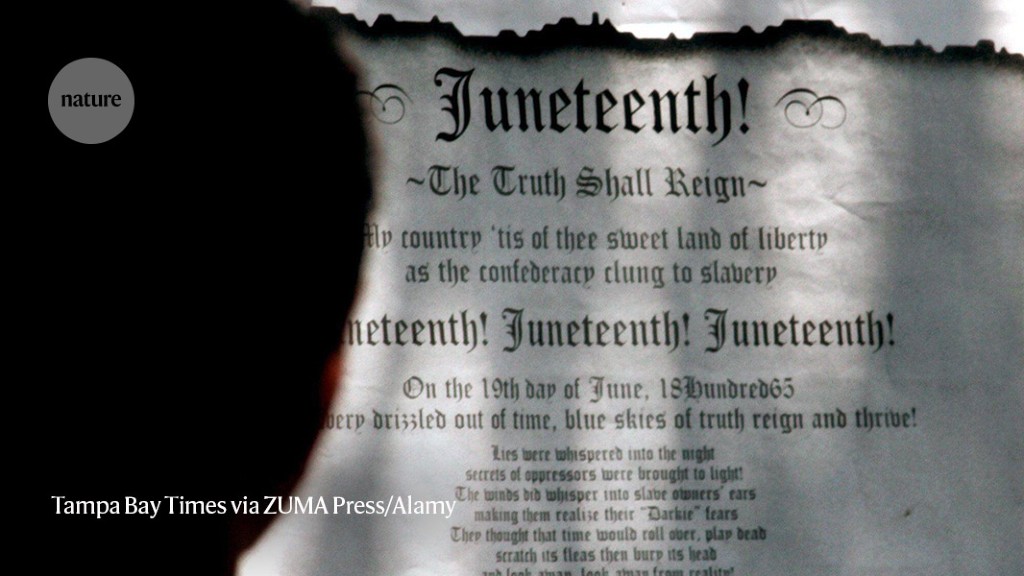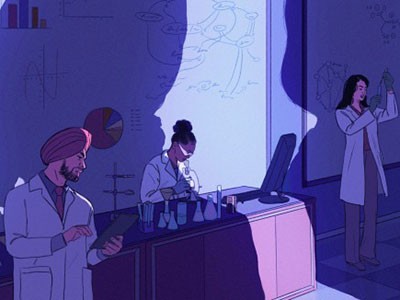Politics
Why Juneteenth matters for science

Juneteenth, an annual commemoration of the emancipation of enslaved African Americans in the United States, holds immense significance in the nation’s history.
It has been marked in various forms since 19 June 1866, a year after the Emancipation Proclamation of 1863 finally reached Texas in the wake of the American Civil War. On 19 June 1865, more than two months after Confederate troops surrendered, slaves in Galveston, Texas, learnt of their freedom in what was the last state to receive news of emancipation.
Although Juneteenth has always symbolized hope, it wasn’t until 2021 that US President Joe Biden declared it a federal holiday.
Yet, despite this belated recognition, it does not feel as if many people understand the historical and contemporary significance of this event. This is especially true in science, which has a troubled history of racism and continues to have a low retention rate of Black researchers, who are much more likely than their white counterparts to drop out of the field1. To help raise Juneteenth’s profile, I and 51 other Black scientists issued a call this year, in the journal Cell2, for science to mark Juneteenth by reducing burdens on researchers from our community and eradicating barriers to equitable science.
My confidence in my ability to thrive as a Black man in academia was bolstered during my postdoctoral training at the University of Iowa in Iowa City. My mentor, E. Dale Abel — now chair of the Department of Medicine at the David Geffen School of Medicine at the University of California, Los Angeles — showed me that it was possible for a Black academic to lead entire departments. However, as I progressed through the scientific pipeline, it became abundantly clear that individuals who are under-represented in science face many barriers that are not commonly discussed, a metaphorical ‘leaky pipeline’ that I explored in my first Cell commentary3, in 2020. As I moved up to a faculty position, I saw many of these same issues continue to go unaddressed. Academic researchers might like to think that science is no longer racist; however, contrary to popular belief, it continues to be so4.
I think many troubling aspects of US history are often neglected in the public consciousness. They include the four-day New York City draft riot in 1863, in which white rioters attacked African American workers and their properties; the race riots in Chicago, Illinois, in 1919; and the massacre in Tulsa, Oklahoma, two years later. These are just three examples of events, often catalysed by police inaction, that resulted in the loss of Black lives, livelihoods and homes. Black communities have also been negatively affected by economic policies such as redlining, a form of discrimination in which mortgages, insurance and other financial services are denied on the basis of applicants’ race or ethnicity. And yet in Texas today, the very state from which Juneteenth originated, there have been more than 180 bills in the 88th Texas legislature targeting higher education, which together aim to defund diversity offices and ban certain topics from being discussed5.
Casualty of politics
The US Supreme Court ruling in June that overturned affirmative-action policies spells an end to race-based university admissions, and might undo much of the increased diversity that US science has seen in recent decades. As critical race theory (the idea that racial bias and prejudice is inherent and systemic across Western societies and many of their institutions) has become a contentious point across the country, the true history of African Americans in the United States has become a casualty of politics.
Even if you ignore recent policy changes banning diversity, equity and inclusion (DEI) initiatives across the country, the picture for science remains far from equitable and inclusive. This is exemplified by the lower recruitment and retention rates for Black students and other under-represented groups1,2 — a situation related to numerous factors, including discrimination, preconceived ideas based on skin colour, a lack of role models and inadequate encouragement for young Black students, according to a report6 by the Pew Research Center, a think tank in Washington DC.
Herman Shaw, a survivor of the Tuskegee study, at the White House when a presidential apology for the experiment was issued in 1997.Credit: Richard Ellis/Alamy
Some racial injustices that resulted from scientific research in the United States are well known. The Public Health Service study of untreated syphilis in Black men (the Tuskegee study7), which ran from 1931 until 1972, is one example, but what about the long history of science and medicine being used to discriminate against Black people? Just last month, for example, the biotechnology company Thermo Fisher Scientific, based in Waltham, Massachusetts, reached a confidential settlement with the family of Henrietta Lacks after taking her immortalized cells (known as HeLa cells) and using them without her consent for research purposes. Although this settlement is an encouraging sign of justice, it is just one example in an often-forgotten history.
This is a call to action to ensure that science doesn’t repeat that history. For example, many biomedical researchers use repositories that are mainly composed of samples from individuals of European descent. Efforts to create truly representative repositories are needed. As Juneteenth 2023 was approaching, it became evident that this day was the perfect lens through which to view these considerations. I wanted to write the 2023 Cell article for researchers from every career stage and demographic background to read and then take away an actionable step. So, for example:
• If you are the head of an institution, consider how to revitalize your recruitment by engaging in conversations with Black community leaders and developing partnerships with historically Black colleges and universities.
• If you are a researcher looking at a specific disease, consider expanding your next grant application to study how this disease affects Black communities and the potential disparities associated with it.
• If you are an undergraduate student, suggest that Black scientists be given speaking engagements on your campus, to increase their visibility.
Decolonizing science toolkit
Working with more than 50 co-authors on that Cell article, to ensure that everybody got to discuss what they were passionate about, was difficult at times, but I foresee many future collaborations in which we touch on aspects that were not discussed there.
Having the input of these scientists from a variety of career stages was fundamental to proposing evidence-backed solutions and highlighting the phenomenal work performed by Black scientists.
Within a few days of the article going live, I noticed that it had hundreds of thousands of impressions on Twitter, where it was sparking a vibrant conversation. A few days later, I was invited by the business media site Forbes and CBS TV News to discuss our article.
This met one of the article’s central goals, to show that Black scientists do exist and can thrive despite the barriers they face. This news coverage will hopefully make more people aware internationally that increased diversity is driving the record innovation seen in science8.
But media attention and the opportunity to discuss these issues can only go so far. The article I wrote was not about compiling literature to highlight the issues that many scientists might neglect; rather, it was about offering solutions that could be actioned by everyone from individuals to policymakers.
Indeed, the changes that need to occur in academia will take a collaborative effort at every level. Whenever people reflect on Juneteenth and its historical significance, they should be reminded of the urgency and collaborative effort necessary to break down barriers and foster a more equitable future for Black scientists.
Read the full article here

-

 States2 weeks ago
States2 weeks agoPearlie Golden 93-Year-Old Black Woman Shot By Texas Cop
-

 States2 weeks ago
States2 weeks agoTragedy Unveils Racial Tensions Tarika Wilson Story
-

 States2 weeks ago
States2 weeks agoLayers Of Racial Tension The Mario Woods Tragedy And San Francisco Path To Justice
-

 States2 weeks ago
States2 weeks agoLynching Of Thomas Shipp Tragedy Of Racism Echoes Through History
-

 States2 weeks ago
States2 weeks agoThe Killing Of Terence Crutcher And The Fight For Racial Justice

















You must be logged in to post a comment Login